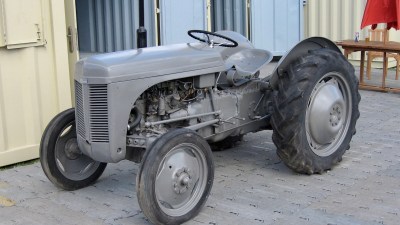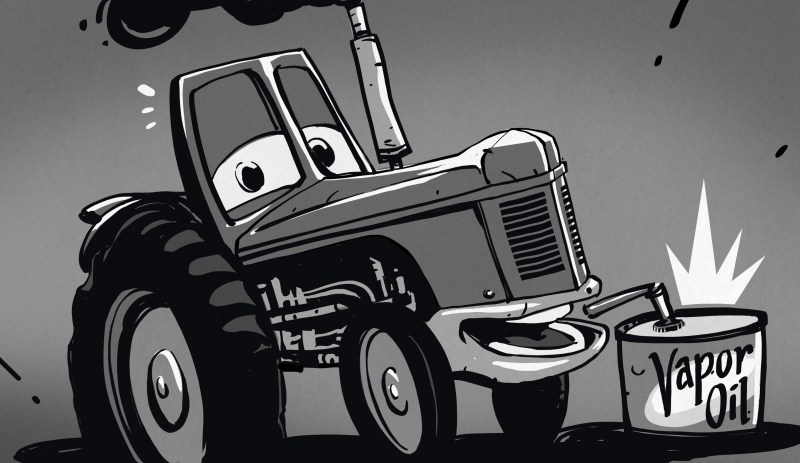Hardware hackers come from a variety of backgrounds, but among us there remains a significant number whose taste for making things was forged through growing up in a farm environment. If that’s you then like me it’s probable that you’ll melt a little at the sight of an older tractor, and remember pretending to drive one like it at pre-school age, and then proudly driving it for real a few years later before you were smart enough to realise you’d been given the tedious job of repeatedly traversing a field at a slow speed in the blazing sun. For me those machines were Ford Majors and 5000s, Nuffields, the ubiquitous red Fergusons, and usually relegated to yard duty by the 1970s, the small grey Ferguson TE20s that are in many ways the ancestor of all modern tractors.
The Black Art Of Mixing Your Own Fuel
There was something odd about some of those grey Fergies in the 1970s, they didn’t run on diesel like their newer bretheren, nor did they run on petrol or gasoline like the family Austin. Instead they ran on an unexpected mixture of petrol and heating oil, which as far as a youthful me could figure out, was something of a black art to get right. I’d had my first encounter with Tractor Vapour Oil, or TVO, a curious interlude in the history of agricultural engineering. It brings together an obscure product of the petrochemical industry, a moment when diesel engine technology hadn’t quite caught up with the on-farm requirement, and a governmental lust for a lower-tax tractor fuel that couldn’t be illicitly used in a car.
TVO is a fuel with a low octane rating, where the octane rating is the resistance to ignition through compression alone. In chemical terms octane rating a product of how many volatile aromatic hydrocarbons are in the fuel, and to illustrate it your petrol/gasoline has an octane rating in the high 90s, diesel fuel has one close to zero, and TVO has a figure in the 50s. In practice this was achieved at the refinery by taking paraffin, or kerosene for Americans, a heavier fraction than petrol/gasoline, and adding some of those aromatic hydrocarbons to it. The result was a fuel on which a standard car engine wouldn’t run, but which would run on a specially low-compression engine with a normal spark ignition. This made it the perfect tax exempt fuel for farmers because it could only be used in tractors equipped with these engines, and thus in the years after WW2 a significant proportion of those Fergies and other tractors were equipped to run on it.
When Diesels Were Still Slow-Revving
One might ask why post war tractors were not simply equipped with diesel engines, and the answer there comes with the state of diesel engine development in the mid-century. It’s easy to make a large diesel engine which can run at constant slow revs, but at the time it was not so easy to make one which was small, powerful, and responsive at different speeds. Thus there were tractors with huge single-cylinder diesels running their entire length which used to rock backwards and forwards with the revolution of their engines, but farmers would have to wait for widespread adoption of the swirl chamber on diesel engines through the 1950s before they’d get their responsive and higher-revving diesel tractors.

That was about the time a pre-school me was gazing up at my dad’s diesel Fordson Major, and our neighbour was mixing up fake TVO for his yard tractor. As far as I am aware the UK government still frowns upon illicit fuel mixing so there are official licenses to make your own TVO, and I understand the owners association for the grey Fergie has one so those over-restored examples at the village fete aren’t breaking the law.
I may no longer have a direct connection with farming, but I still from time to time get to sit in the cab of a modern tractor whose computer controlled turbo diesel engine and near-perfect transmission are up to any task. These machines are as far as it goes, perfected. But there’s still part of me that’s more at home with a clutch and two gear levers, and the sulphurous tang of 1970s tractor exhaust mixed with the smell of freshly turned earth. I must stay away from Farmer’s Weekly, or I could find myself mixing TVO for myself.















my tractor is a fordson major supper major
which was aquired in pieces,and it has a 3 point hitch
drawbar hitch,rear standard pto
side mounted flat belt pto
planetary gear underdrive transmission
and half tracks
so a supper major with parts from a major
it will run on piss and brake fluid or anything else
you care to put in the tank
and my horse likes to pull the headlights off
An old(er) friend tells of his family’s having owned a Model A Ford which ran very comfortably on diesel fuel / heating oil, after having started the engine on gasoline (low-octane, of course).
Low-compression-ratio engines are great for hacking. And for saving money.
It was around the same era that diesel tractors began to appear in the USA.
To get them started some had a “pony engine”, i.e. a small gasoline engine to crank the larger diesel engine up to running speed/temperature. Some had spark plugs in the cylinders and would start with gasoline until it was ready to switch to the diesel fuel.
Yeah, some had a carburetor on one side and an injector pump on the other. Kinda confusing.
“Tractors is so dumb!”
-Tow Mater
“the UK government still frowns upon (…) so there are official licenses” – This sounds to my American ears like the most typically UK thing since tea and colonialism. :P
Those huge slow diesel tractors had a neat trick; one or another kind could run their engine in both directions, or you could idle in gear, oscillating in place, by adjusting it to never quite complete a full revolution.
The modern ones, especially the newest even of the small sizes, with hydrostatic transmissions – that’s a wonderful feature to have. But back in this era would be when a three-point hitch that could be lifted and lowered was an improvement over just pulling something that had its own wheels. And a shaft-based PTO? I never used the older stuff, but some stuff used to be powered just by dragging its wheels, and the other option was to park, get out a giant flat leather belt and hook it up to a convex cylinder shaped pulley coming out the side of the tractor somewhere, and do all kinds of twists and criss-crosses to hook the machine up. Still beats doing things with muscle power though, I would say.
“Single cylinder diesels…”. Ah, the good old Field Marshall, also featuring the “total-loss” oiling system (hint:- don’t wear your Sunday-best when driving one). Lovely sound, though.
“…but among us there remains a significant number whose taste for making things was forged through growing up in a farm environment…”
If you have the slightest inclination towards knowing about the individuals in the history of science and engineering, you’ll know that it is absolutely amazing how many of the luminaries–“workers”; they call themselves “workers”, and not scientists–of these fields grew up on a farm.
“…and then proudly driving it for real a few years later before you were smart enough to realise you’d been given the tedious job of repeatedly traversing a field at a slow speed in the blazing sun…”.
In other words—you’d been duped; you’d been “had”.
There’s an old Pennsylvania Dutch (German) anglicized saying which applies here:
“Ve gets too soon oldt und too late smarts.”
This article makes me realize how much fuel names are a mess internationally.
Sparkie engines run on Petrol (UK), Gasoline (US), Essence (France), Benzine (NL).
Yet..
-Dutch Petroleum is Kerosene in the US and Parraffin in the UK (while dutch Paraffine is what you make tea candles from)
-French Gazole is US/UK diesel.
-French Essence translates as “food”
-Dutch Benzine should not be confused with Benzene, which is a highly toxic base chemical (which in ye olde days was also used as a propulsion fuel)
I studied a little chemistry and what confuses me is that we don’t use specific distilled fuels such as hexane in engines to match the compression ratio. it’s always a mix of different fuels over a wide range sold as diesel or petrol. If you pick up a history book you find petrol referred to as naptha in UK, that’s even more confusing.
I think most engines were built to run on available fuels, or on thus far unusable fractions of the distillation (“waste fuels”), instead of very refined fuels that were created to be optimal for the engine, except for specialty engines like rockets.
Refining crude oil (or vegetable oils) is more complex and thus more expensive the more refined you want your end products to be.
And TVO was known as “distillate” in the US
a compliment that comes from the Soviet Union given to
someone in rural area goes like this : “strong like OX” pats
bicept, “smart like TRACTOR ” touches head
use your best ruski accent
This was actually used in cars in Finland also up to the 80’s. The Finnish-made SAAB 99 as well as Talbot Horizon had dual-fuel models, started on gasoline and then switched to petroleum aka TVO after reaching working temperature. Here is a site in English: http://saabisti.fi/saab-99-petro/ .
Still remember when the local fuel station had it on pump.
We had a Ford 8N that routinely caught fire when the starter solenoid sparked. It was common enough that my grandfather would sometime do it on purpose just to scare our neighbors. It wasn’t until after he passed that I found out we had a pin hole leak in the fuel line that closed up after the engine got warm and the rubber expanded a bit. Turns out he used the wrong kind of rubber hose and just dipped it in liquid rubber so no one would notice. That is subsistence farming in a nutshell though, fix it with what ever is immediately within reach until you can afford the real part.
The Massey Ferguson tractor I grew up with had the starter on the gear shift lever (1-2-3-4-R-S) and there was a truck, you had to pull the lever up to move it to the right for Start. I was 6 years old before I figured that out.
It also had twin steering rods right by the clutch and brake pedals, so you could steer with your feet.
And here I am thinking this is an article about TV Ontario.
Why has nobody mentioned the beautiful smell of T V O exhaust, a memory of my childhood on a small farm